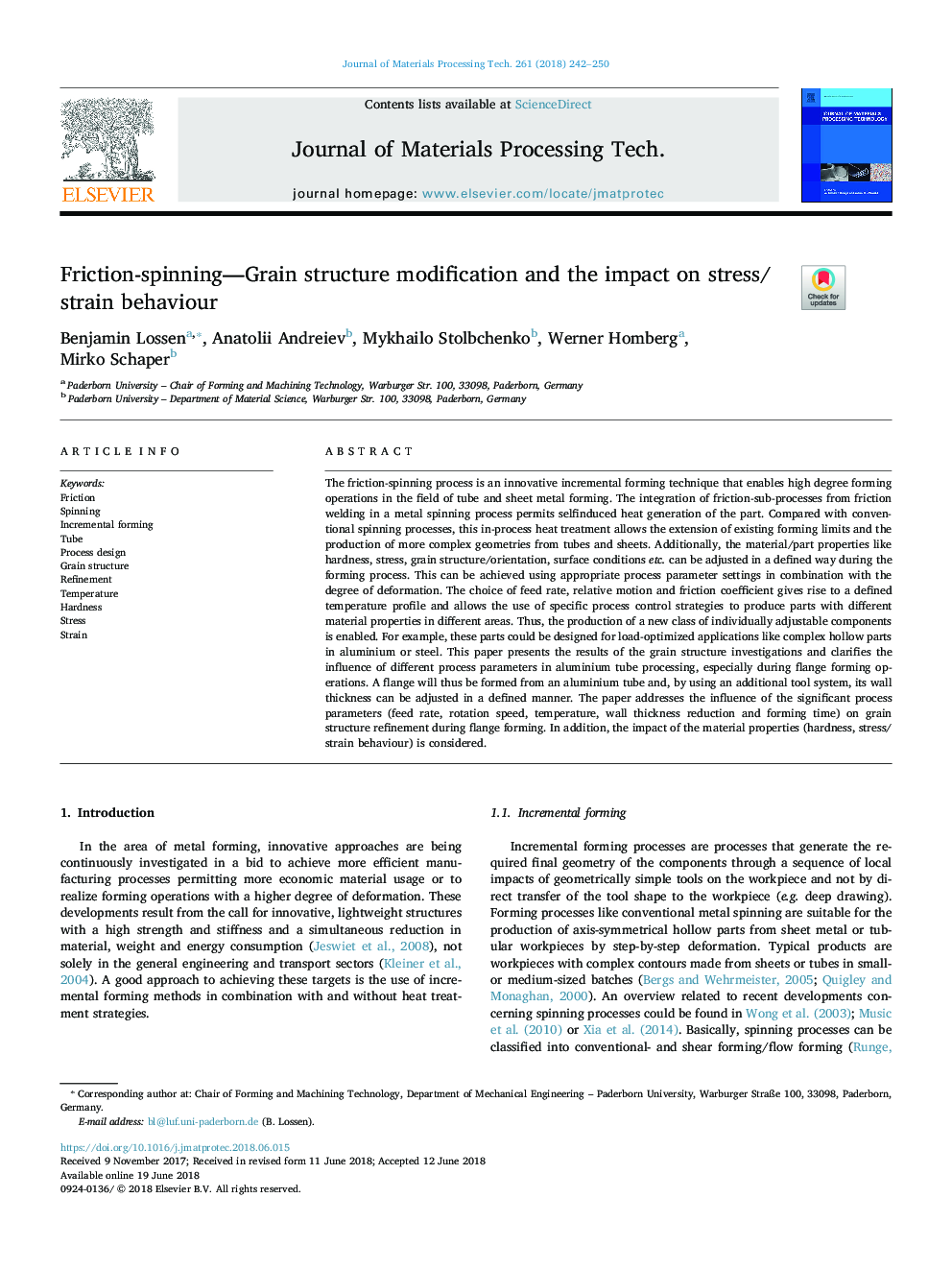| کد مقاله | کد نشریه | سال انتشار | مقاله انگلیسی | نسخه تمام متن |
|---|---|---|---|---|
| 7176251 | 1466706 | 2018 | 9 صفحه PDF | دانلود رایگان |
عنوان انگلیسی مقاله ISI
Friction-spinning-Grain structure modification and the impact on stress/strain behaviour
ترجمه فارسی عنوان
تغییر ساختار اصطکاک، چرخش دانه و تاثیر بر رفتار استرس / فشار
دانلود مقاله + سفارش ترجمه
دانلود مقاله ISI انگلیسی
رایگان برای ایرانیان
کلمات کلیدی
اصطکاک، حال چرخش، تشکیل تکمیلی، لوله، طراحی فرآیند، ساختار دانه، اصلاح، درجه حرارت، سختی فشار، نژاد،
ترجمه چکیده
فرآیند چرخش اصطکاکی یک تکنیک تشکیل نوآورانه ای است که امکان انجام عملیات تشکیل درجه بالا در زمینه تشکیل لوله و ورق را فراهم می کند. ادغام فرایندهای اصطکاکی از جوشکاری اصطکاک در فرآیند چرخش فلزی اجازه می دهد تولید گرما تولید شده توسط خود را به دست آورد. در مقایسه با فرآیندهای معمولی چرخش، این عملیات حرارتی در فرآیند اجازه می دهد تا گسترش محدودیت های تشکیل موجود و تولید هندسه های پیچیده تر از لوله ها و ورق ها. علاوه بر این، خواص مواد / قسمت مانند سختی، استرس، ساختار / جهت دانه، شرایط سطح و غیره می تواند در طول فرایند تشکیل یک روش مشخص تنظیم شود. این را می توان با استفاده از تنظیمات پارامترهای فرعی مناسب در ترکیب با درجه تغییر شکل بدست آورد. انتخاب میزان تغذیه، حرکت نسبی و ضریب اصطکاک به یک پروفیل درجه حرارت تعریف می شود و اجازه می دهد تا از استراتژی های کنترل فرآیند خاص برای تولید قطعات با خواص مواد مختلف در مناطق مختلف استفاده شود. بنابراین تولید یک کلاس جدید از اجزای قابل تنظیم به صورت جداگانه فعال می شود. به عنوان مثال، این قطعات را می توان برای کاربردهای بهینه سازی شده بار مانند قطعات پیچیده توخالی در آلومینیوم یا فولاد طراحی کرد. این مقاله نتایج تحقیقات ساختار دانه را نشان می دهد و تاثیر پارامترهای مختلف فرایند را در پردازش لوله های آلومینیومی، به ویژه در عملیات شکل گیری فلنج، روشن می کند. بنابراین فلنج از یک لوله آلومینیوم تشکیل می شود و با استفاده از یک سیستم ابزار اضافی، ضخامت دیوار آن می تواند به نحوی مشخص تنظیم شود. در مقاله، تاثیر پارامترهای فرایندهای مهم (سرعت تغذیه، سرعت چرخش، دما، کاهش ضخامت دیوار و زمان شکل گیری) بر پالایش ساختار دانه در طول تشکیل فلنج مورد بررسی قرار گرفته است. علاوه بر این، تاثیر خواص مواد (سختی، رفتار تنش / تنش) در نظر گرفته می شود.
موضوعات مرتبط
مهندسی و علوم پایه
سایر رشته های مهندسی
مهندسی صنعتی و تولید
چکیده انگلیسی
The friction-spinning process is an innovative incremental forming technique that enables high degree forming operations in the field of tube and sheet metal forming. The integration of friction-sub-processes from friction welding in a metal spinning process permits selfinduced heat generation of the part. Compared with conventional spinning processes, this in-process heat treatment allows the extension of existing forming limits and the production of more complex geometries from tubes and sheets. Additionally, the material/part properties like hardness, stress, grain structure/orientation, surface conditions etc. can be adjusted in a defined way during the forming process. This can be achieved using appropriate process parameter settings in combination with the degree of deformation. The choice of feed rate, relative motion and friction coefficient gives rise to a defined temperature profile and allows the use of specific process control strategies to produce parts with different material properties in different areas. Thus, the production of a new class of individually adjustable components is enabled. For example, these parts could be designed for load-optimized applications like complex hollow parts in aluminium or steel. This paper presents the results of the grain structure investigations and clarifies the influence of different process parameters in aluminium tube processing, especially during flange forming operations. A flange will thus be formed from an aluminium tube and, by using an additional tool system, its wall thickness can be adjusted in a defined manner. The paper addresses the influence of the significant process parameters (feed rate, rotation speed, temperature, wall thickness reduction and forming time) on grain structure refinement during flange forming. In addition, the impact of the material properties (hardness, stress/strain behaviour) is considered.
ناشر
Database: Elsevier - ScienceDirect (ساینس دایرکت)
Journal: Journal of Materials Processing Technology - Volume 261, November 2018, Pages 242-250
Journal: Journal of Materials Processing Technology - Volume 261, November 2018, Pages 242-250
نویسندگان
Benjamin Lossen, Anatolii Andreiev, Mykhailo Stolbchenko, Werner Homberg, Mirko Schaper,
